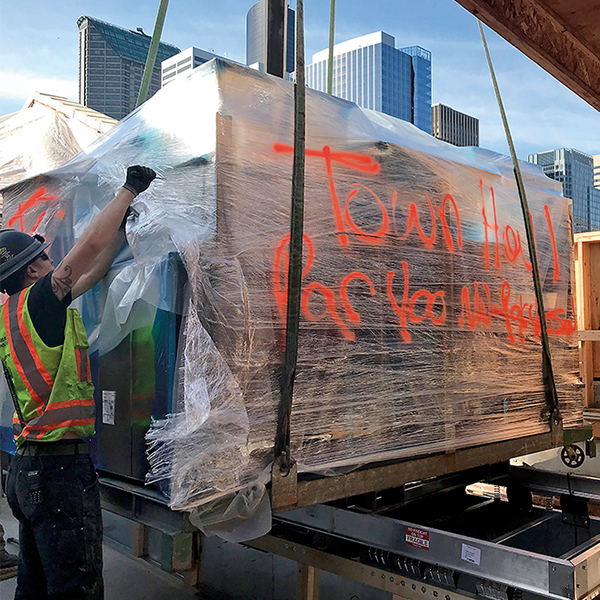.
Construction Special Projects: Making our mark at a landmark
After a century of use, a Seattle landmark venue is getting an overhaul. Town Hall is a non-profit performance theatre that provides affordable accessibility for its programs and community. The historic building was built during the peak of the Christian Science movement between 1916-1922 for the Fourth Church of Christ, Scientists. The congregation was the sole and continuous occupant of the building until it was sold to Town Hall in 1998.
Our scope of work for this plan/spec project includes HVAC, piping, plumbing, and controls. The new mechanical systems, which are vital improvements to the building, are oversized (large ducts with many vents) to reduce vibration and noise. Additionally, to reduce mechanical system noise from interfering with performances, the main performance hall has a separate system, so it’s acoustically isolated from lower floors which also have their own system.
A huge part of this story is the execution of a highly successful new type of workflow. Our teams (wet and dry) are more effectively integrating existing project data into their workflows – we are moving away from ‘one-off’ estimates. To realize a cost savings, the estimating model had to be precise and accurate enough for Detailing to use, yet had to be completed within the standard estimate turn-over cycle.
The estimating contribution to this (Town Hall) piece is the cost savings involved for the Detailing effort. By their account, approximately 120 hours were saved. This is significant, as a direct estimating-to-detailing model has not been done before.
This initiative entailed a combined effort from Trevor Moser (Estimating) who gave Clint McCann (Sheet Metal) and Joe Wolleat (Detailing) insight into the project, and who reviewed the drawings and helped identify how to tackle such a unique project.
Also, because there are no control points or gridlines in the attic for the field to measure for install, Luke Barendse (Detailing) provided panoramic renderings via Navisworks utilizing QR codes on the field’s install drawings. Thus, the field could see the 3D duct installed on their iPhones in reference to their 2D install drawings.
This was a huge asset to the field team, as it enabled them to instantly visualize systems with changing elevations and routing through a domed attic area that would otherwise be difficult and time consuming to decipher.
Of course, none of this would have been possible without our partnership with the engineer, Mazzetti. The architectural model was Trimble mapped so we had an accurate description of the attic, where most of our scope resided. We could completely experience the space and see how our systems would fit in this complex attic space. From day one, Joe could work with estimating’s design line model and start incorporating portions of that design to catapult the time it took to detail the project.
Overall, over 45,000 pounds of total duct was sent to the fabrication shop, which allowed the field foreman to bypass hand take-off in an attic that was mostly inaccessible at project startup. This helped the field keep to schedule and eliminate the time needed to field measure and order that much material.
The ability to interpret, integrate, improve and disseminate accurate project data in the design-pipeline allows MacMiller to keep a real-time finger on the pulse of project costs. The renovation of the 35,731 SF performance arts building will be complete in March of 2019. To read this article in its entirety visit our blog.

Read more articles from our Perspective Newsletter.
